ZHCSC50B February 2014 – September 2014 TPS22961
PRODUCTION DATA.
- 1 特性
- 2 应用范围
- 3 说明
- 4 简化电路原理图
- 5 修订历史记录
- 6 Terminal Configuration and Functions
- 7 Specifications
- 8 Detailed Description
- 9 Applications and Implementation
- 10Power Supply Recommendations
- 11Layout
- 12器件和文档支持
- 13机械封装和可订购信息
7 Specifications
7.1 Absolute Maximum Ratings
Over operating free-air temperature range (unless otherwise noted)(1)| MIN | MAX | UNIT | ||
|---|---|---|---|---|
| VIN | Input voltage range | –0.3 | 4 | V |
| VBIAS | Bias voltage range | –0.3 | 6 | V |
| VOUT | Output voltage range | –0.3 | 4 | V |
| VON | ON pin voltage range | –0.3 | 6 | V |
| IMAX | Maximum Continuous Switch Current | 6 | A | |
| IPLS | Maximum Pulsed Switch Current, pulse < 300 µs, 2% duty cycle | 8 | A | |
| TA | Operating free-air temperature range | –40 | 85 | °C |
| TJ | Maximum junction temperature | 125 | °C |
(1) Stresses beyond those listed under Absolute Maximum Ratings may cause permanent damage to the device. These are stress ratings only, which do not imply functional operation of the device at these or any other conditions beyond those indicated under Recommended Operating Conditions. Exposure to absolute-maximum-rated conditions for extended periods may affect device reliability.
7.2 Handling Ratings
| MIN | MAX | UNIT | ||
|---|---|---|---|---|
| TSTG | Storage temperature range | –65 | 150 | °C |
| TLEAD | Maximum lead temperature (10-s soldering time) | 300 | °C | |
| VESD (1) | Human-Body Model (HBM)(2) | 2 | kV | |
| Charged-Device Model (CDM)(3) | 1 | kV |
(1) Electrostatic discharge (ESD) to measure device sensitivity and immunity to damage caused by assembly line electrostatic discharges in to the device.
(2) Level listed above is the passing level per ANSI, ESDA, and JEDEC JS-001. JEDEC document JEP155 states that 500-V HBM allows safe manufacturing with a standard ESD control process.
(3) Level listed above is the passing level per EIA-JEDEC JESD22-C101. JEDEC document JEP157 states that 250-V CDM allows safe manufacturing with a standard ESD control process.
7.3 Recommended Operating Conditions
Over operating free-air temperature range (unless otherwise noted)| MIN | MAX | UNIT | |||
|---|---|---|---|---|---|
| VIN | Input voltage range | 0.8 | VBIAS – 1.95 | V | |
| VBIAS | Bias voltage range | 3 | 5.5 | V | |
| VON | ON voltage range | 0 | 5.5 | V | |
| VOUT | Output voltage range | VIN | V | ||
| VIH, ON | High-level voltage, ON | VBIAS = 3 V to 5.5 V | 1.2 | 5.5 | V |
| VIL, ON | Low-level voltage, ON | VBIAS = 3 V to 5.5 V | 0 | 0.5 | V |
| CIN | Input Capacitor | 1(1) | µF | ||
(1) Refer to Detailed Description section.
7.4 Thermal Information
| THERMAL METRIC(1) | TPS22961 | UNIT | |
|---|---|---|---|
| DNY | |||
| 8 PINS | |||
| θJA | Junction-to-ambient thermal resistance | 44.6 | °C/W |
| θJCtop | Junction-to-case (top) thermal resistance | 44.4 | |
| θJB | Junction-to-board thermal resistance | 17.6 | |
| ψJT | Junction-to-top characterization parameter | 0.4 | |
| ψJB | Junction-to-board characterization parameter | 17.4 | |
| θJCbot | Junction-to-case (bottom) thermal resistance | 1.1 | |
(1) For more information about traditional and new thermal metrics, see the IC Package Thermal Metrics application report, SPRA953.
7.5 Electrical Characteristics, VBIAS = 5.0 V
Unless otherwise noted, the specification in the following table applies over the operating ambient temperature–40°C ≤ TA ≤ 85°C (full) and VBIAS = 5.0 V. Typical values are for TA = 25°C (unless otherwise noted).
| PARAMETER | TEST CONDITIONS | TA | MIN | TYP | MAX | UNIT | ||
|---|---|---|---|---|---|---|---|---|
| POWER SUPPLIES AND CURRENTS | ||||||||
| IQ, VBIAS | VBIAS quiescent current | IOUT = 0, VIN = 3 V, VON = VBIAS = 5.0 V |
Full | 0.6 | 1 | µA | ||
| ISD, VBIAS | VBIAS shutdown current | VON = 0 V, VOUT = 0 V | Full | 0.6 | 1 | µA | ||
| ISD, VIN | VIN shutdown current | VON = 0 V, VOUT = 0 V |
VIN = 3.0 V | Full | 0.0009 | 0.1 | µA | |
| VIN = 2.5 V | 0.0008 | 0.1 | ||||||
| VIN = 2.0 V | 0.0007 | 0.1 | ||||||
| VIN = 1.05 V | 0.0007 | 0.1 | ||||||
| VIN = 0.8 V | 0.0006 | 0.1 | ||||||
| ION | ON terminal input leakage current | VON = 5.5 V | Full | 0.1 | µA | |||
| RESISTANCE CHARACTERISTICS | ||||||||
| RON | ON-state resistance | IOUT = –200 mA, VBIAS = 5.0 V |
VIN = 3.0 V | 25°C | 6.5 | 8 | mΩ | |
| Full | 8.8 | |||||||
| VIN = 2.5 V | 25°C | 5.3 | 6.3 | mΩ | ||||
| Full | 7.2 | |||||||
| VIN = 2.0 V | 25°C | 4.8 | 5.8 | mΩ | ||||
| Full | 6.7 | |||||||
| VIN = 1.05 V | 25°C | 4.4 | 5.3 | mΩ | ||||
| Full | 6.2 | |||||||
| VIN = 0.8 V | 25°C | 4.3 | 5.3 | mΩ | ||||
| Full | 6.1 | |||||||
| RPD | Output pulldown resistance | VIN = 5.0 V, VON = 0 V, VOUT = 1 V | Full | 260 | 300 | Ω | ||
7.6 Electrical Characteristics, VBIAS = 3.0 V
Unless otherwise noted, the specification in the following table applies over the operating ambient temperature–40°C ≤ TA ≤ 85°C (full) and VBIAS = 3.0 V. Typical values are for TA = 25°C unless otherwise noted.
| PARAMETER | TEST CONDITIONS | TA | MIN | TYP | MAX | UNIT | ||
|---|---|---|---|---|---|---|---|---|
| POWER SUPPLIES AND CURRENTS | ||||||||
| IQ, VBIAS | VBIAS quiescent current | IOUT = 0, VIN = 1 V, VON = VBIAS = 3.0 V |
Full | 0.3 | 1 | µA | ||
| ISD, VBIAS | VBIAS shutdown current | VON = 0 V, VOUT = 0 V | Full | 0.3 | 1 | µA | ||
| ISD, VIN | VIN shutdown current | VON = 0 V, VOUT = 0 V |
VIN = 1.05 V | Full | 0.001 | 0.1 | µA | |
| VIN = 0.8 V | 0.0008 | 0.1 | ||||||
| ION | ON terminal input leakage current | VON = 5.5 V | Full | 0.1 | µA | |||
| RESISTANCE CHARACTERISTICS | ||||||||
| RON | ON-state resistance | IOUT = –200 mA, VBIAS = 3.0 V |
VIN =1.05 V | 25°C | 6.7 | 8.4 | mΩ | |
| Full | 9.2 | |||||||
| VIN = 0.8 V | 25°C | 5.8 | 7.0 | mΩ | ||||
| Full | 7.9 | |||||||
| RPD | Output pull-down resistance | VIN = 3V, VON = 0 V, VOUT = 1 V | Full | 260 | 300 | Ω | ||
7.7 Switching Characteristics
Refer to the timing test circuit in Figure 1 (unless otherwise noted) for references to external components used for the test condition in the switching characteristics table.| PARAMETER | TEST CONDITION | MIN | TYP | MAX | UNIT | |
|---|---|---|---|---|---|---|
| VIN = 2.5 V, VON = VBIAS = 5 V, TA = 25ºC (unless otherwise noted) | ||||||
| tON | Turn-on time | RL = 10 Ω, CL = 0.1 µF | 10.0 | µs | ||
| tOFF | Turn-off time | 3.5 | ||||
| tR | VOUT rise time | 6.3 | ||||
| tF | VOUT fall time | 2.0 | ||||
| tD | Delay time | 8.1 | ||||
| VIN = 1.05 V, VON = VBIAS = 5 V, TA = 25ºC (unless otherwise noted) | ||||||
| tON | Turn-on time | L = 2.2 µH (DCR = 0.33 Ω), C = 2 x 22 µF (Refer to Typical Application Powering Rails Sensitive to Ringing and Overvoltage due to Fast Rise Time and Figure 31) |
8.1 | 11.3 | 17.3 | µs |
| tOFF | Turn-off time | 13700 | ||||
| tR | VOUT rise time | 5 | 9.5 | 12.5 | ||
| tF | VOUT fall time | 44200 | ||||
| tD | Delay time | 6.7 | 9.3 | 12.5 | ||
| VIN = 0.8 V, VON = VBIAS = 5 V, TA = 25ºC (unless otherwise noted) | ||||||
| tON | Turn-on time | RL = 10 Ω, CL = 0.1 µF | 9.7 | µs | ||
| tOFF | Turn-off time | 6.0 | ||||
| tR | VOUT rise time | 3.2 | ||||
| tF | VOUT fall time | 1.8 | ||||
| tD | Delay time | 8.1 | ||||
| VIN = 1.05 V, VON = 5 V, VBIAS = 3.0 V, TA = 25ºC (unless otherwise noted) | ||||||
| tON | Turn-on time | RL = 10 Ω, CL = 0.1 µF | 19.1 | µs | ||
| tOFF | Turn-off time | 4.7 | ||||
| tR | VOUT rise time | 9.0 | ||||
| tF | VOUT fall time | 2.0 | ||||
| tD | Delay time | 15.6 | ||||
| VIN = 0.8 V, VON = 5 V, VBIAS = 3.0 V, TA = 25ºC (unless otherwise noted) | ||||||
| tON | Turn-on time | RL = 10 Ω, CL = 0.1 µF | 19.0 | µs | ||
| tOFF | Turn-off time | 5.4 | ||||
| tR | VOUT rise time | 7.0 | ||||
| tF | VOUT fall time | 1.9 | ||||
| tD | Delay time | 15.7 | ||||
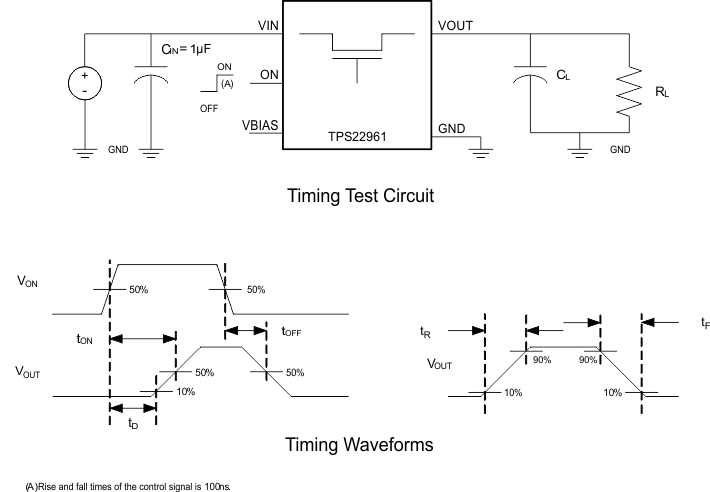 Figure 1. Switching Characteristics Measurement Setup and Definitions
Figure 1. Switching Characteristics Measurement Setup and Definitions
7.8 Typical Characteristics
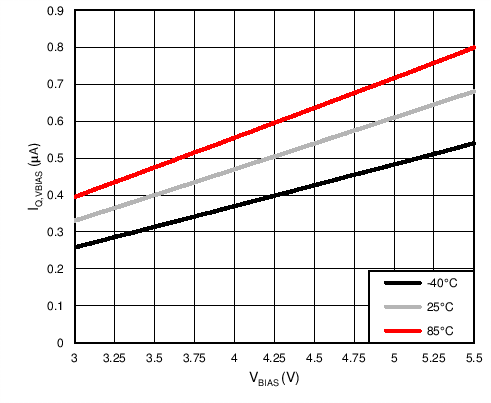
| VIN = 1.05 V | VON = 5 V | IOUT = 0 A |
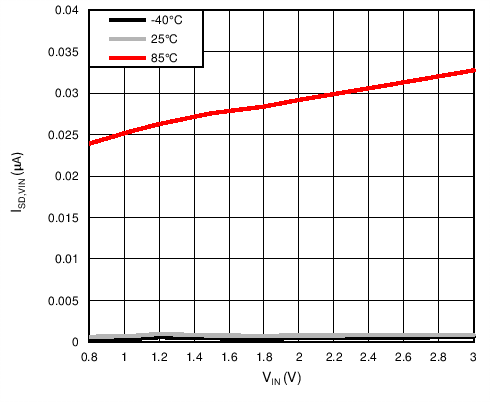
| VBIAS = 5 V | VON = 0 V | VOUT = 0 V |
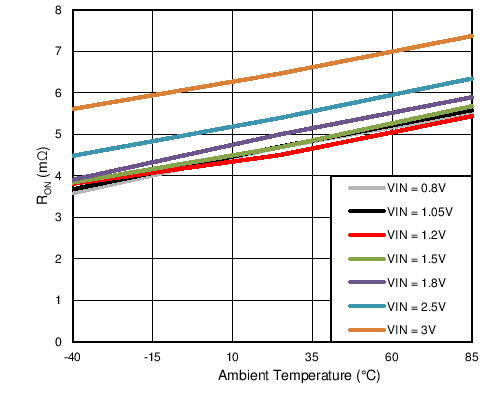
| VBIAS = 5 V | VON = 5 V | IOUT = –200 mA |
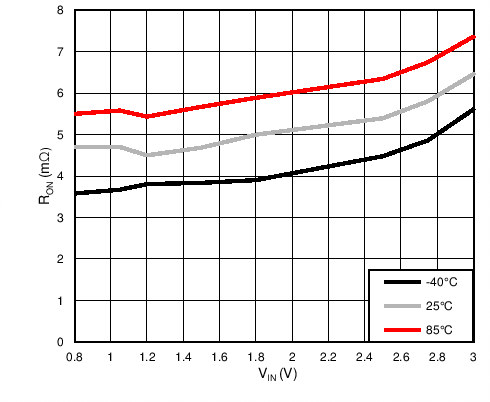
| VBIAS = 5 V | VON = 5 V | IOUT = –200 mA |
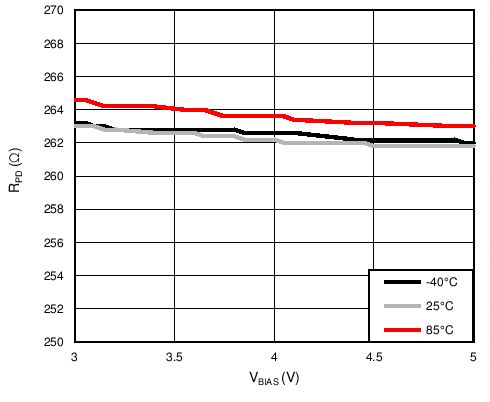
| VON = 0 V | VIN = 1.05 V | VOUT = 1 V |
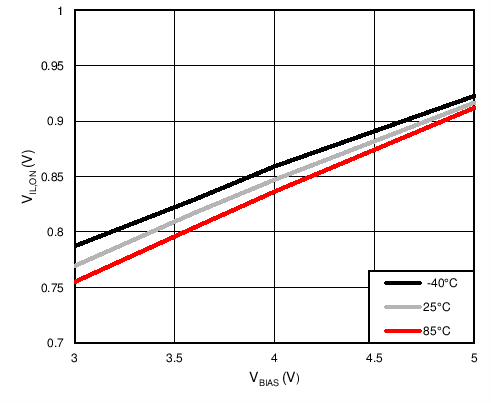
| VIN = VBIAS – 2 V |
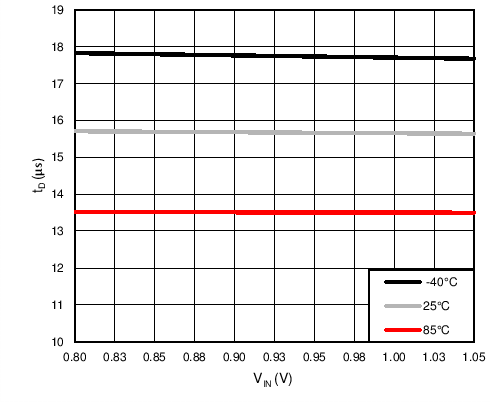
| VBIAS = 3 V | RL = 10 Ω | CL = 0.1 µF |
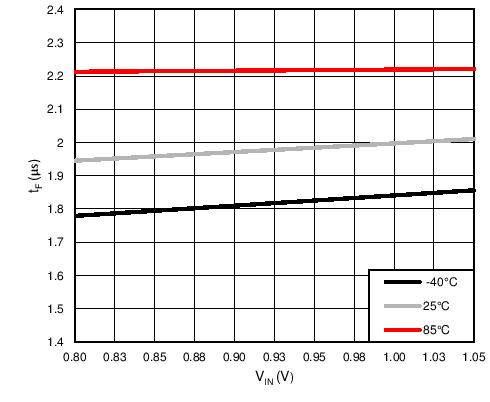
| VBIAS = 3 V | RL = 10 Ω | CL = 0.1 µF |
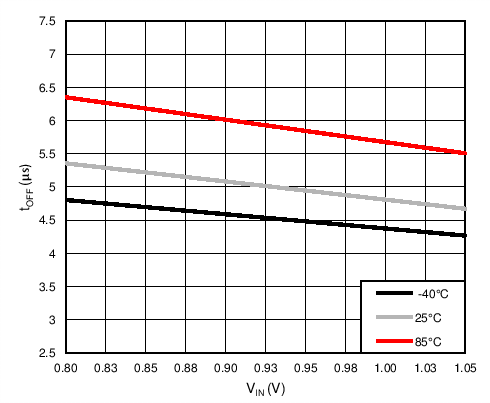
| VBIAS = 3 V | RL = 10 Ω | CL = 0.1 µF |
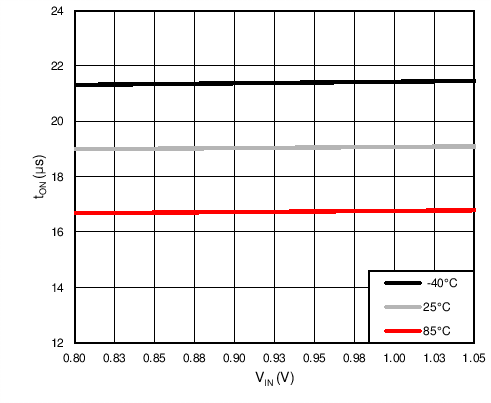
| VBIAS = 3 V | RL = 10 Ω | CL = 0.1 µF |
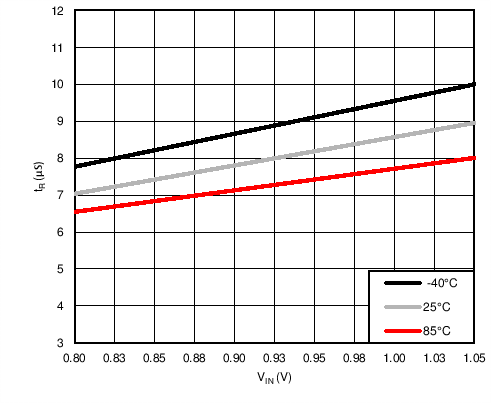
| VBIAS = 3 V | RL = 10 Ω | CL = 0.1 µF |
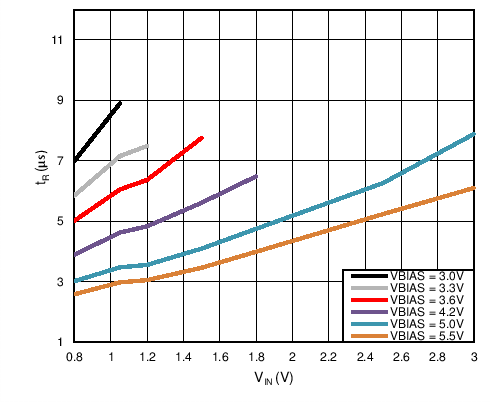
| TA = 25°C | RL = 10 Ω | CL = 0.1 µF |
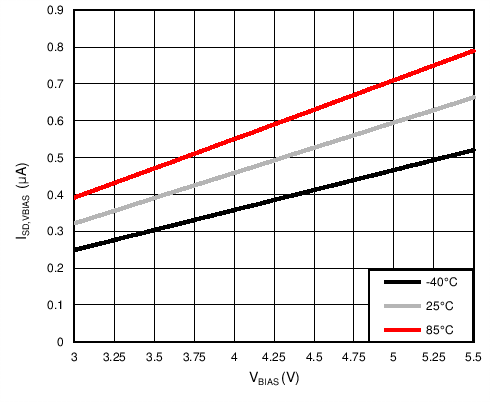
| VON = 0 V | VOUT = 0 V |
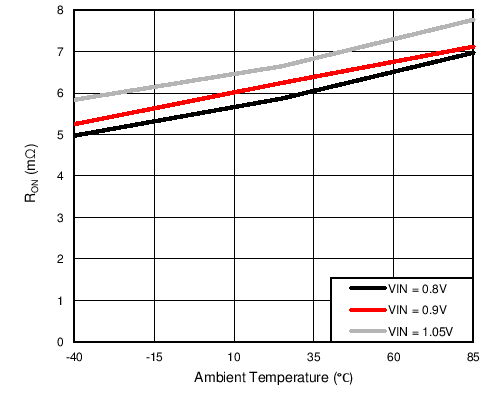
| VBIAS = 3 V | VON = 5 V | IOUT = –200 mA |
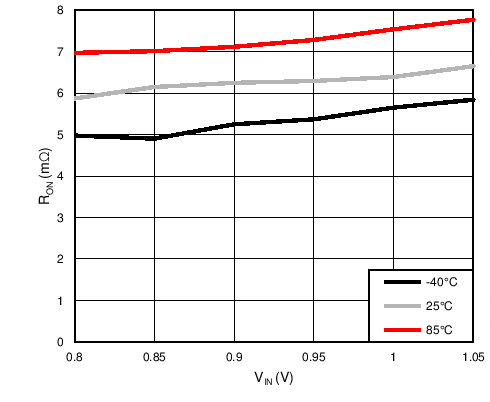
| VBIAS = 3 V | VON = 5 V | IOUT = –200 mA |
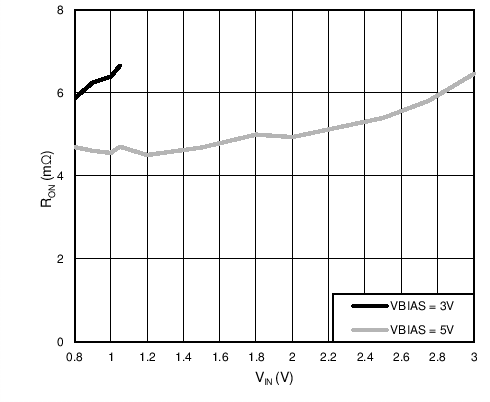
| TA = 25°C | VON = 5 V | IOUT = –200 mA |
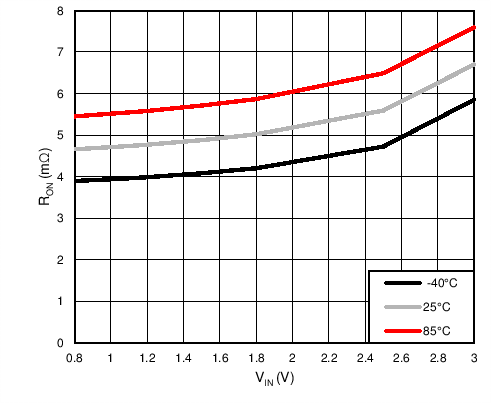
| VBIAS = 5 V | VON = 5 V | IOUT = –6 A |
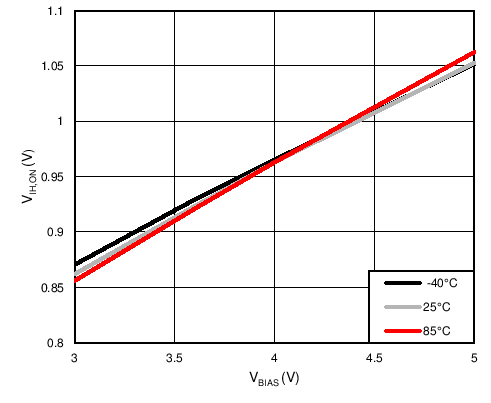
| VIN = VBIAS – 2 V |
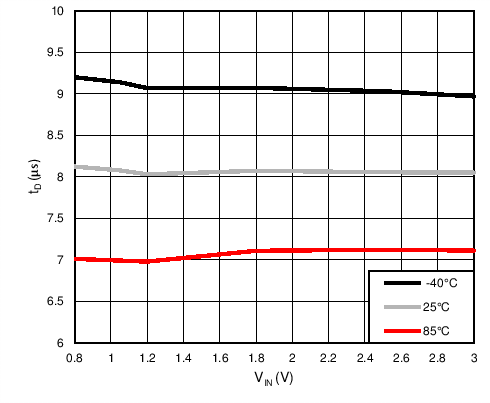
| VBIAS = 5 V | RL = 10 Ω | CL = 0.1 µF |
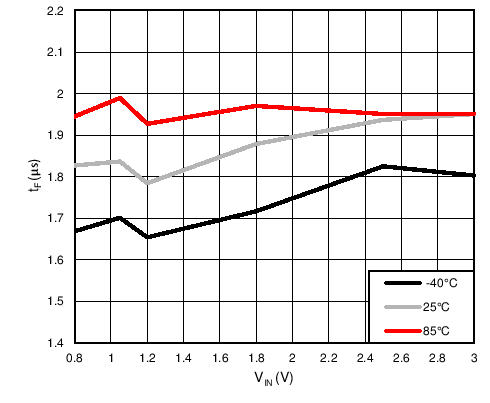
| VBIAS = 5 V | RL = 10 Ω | CL = 0.1 µF |
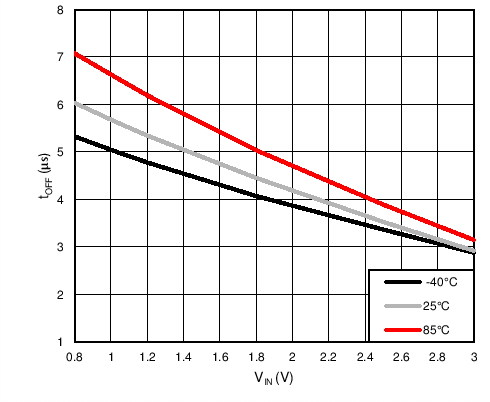
| VBIAS = 5 V | RL = 10 Ω | CL = 0.1 µF |
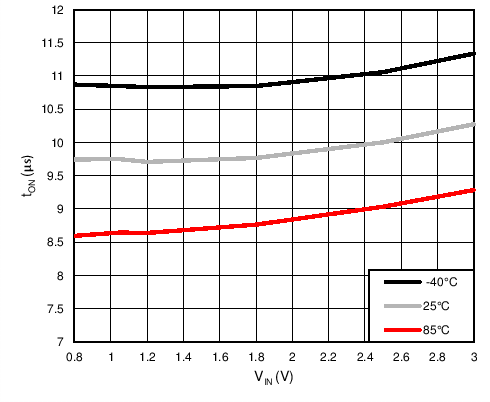
| VBIAS = 5 V | RL = 10 Ω | CL = 0.1 µF |
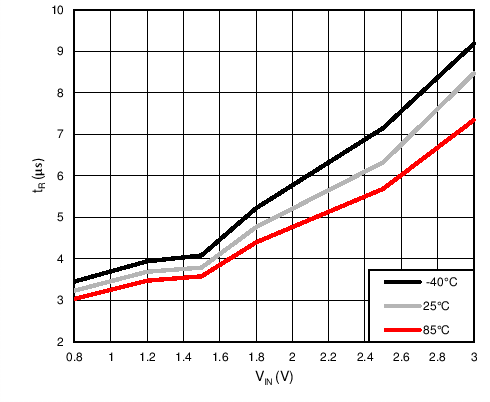
| VBIAS = 5 V | RL = 10 Ω | CL = 0.1 µF |